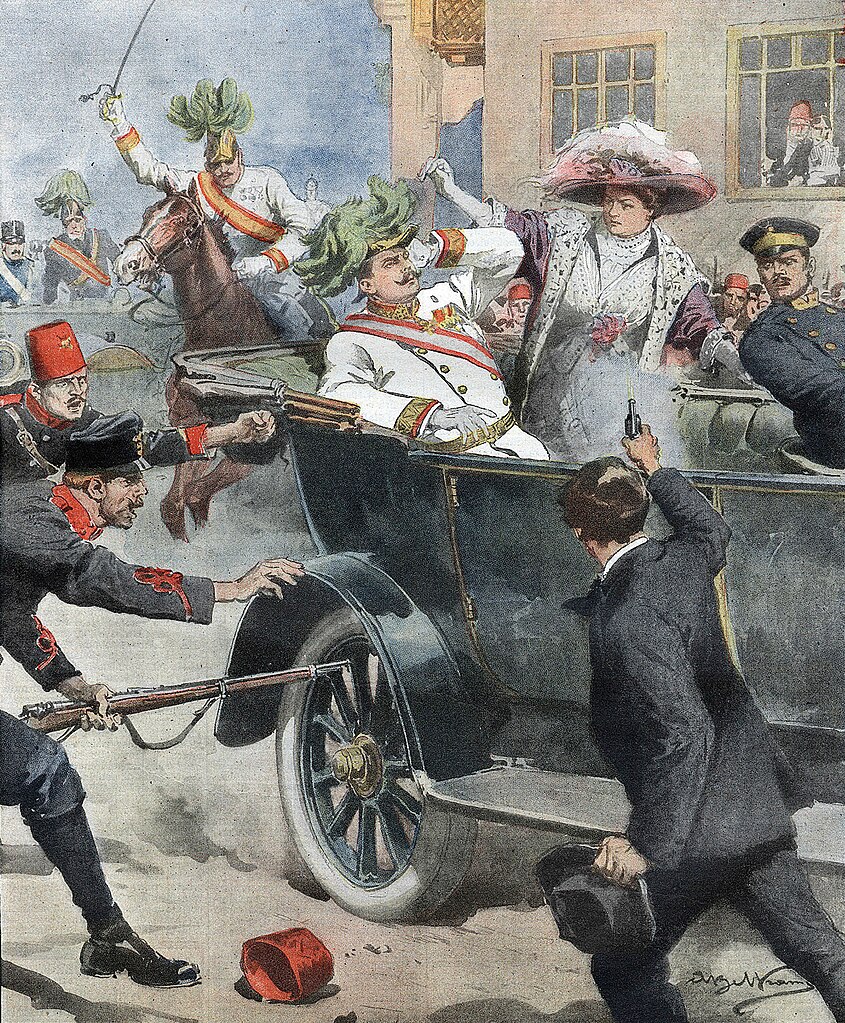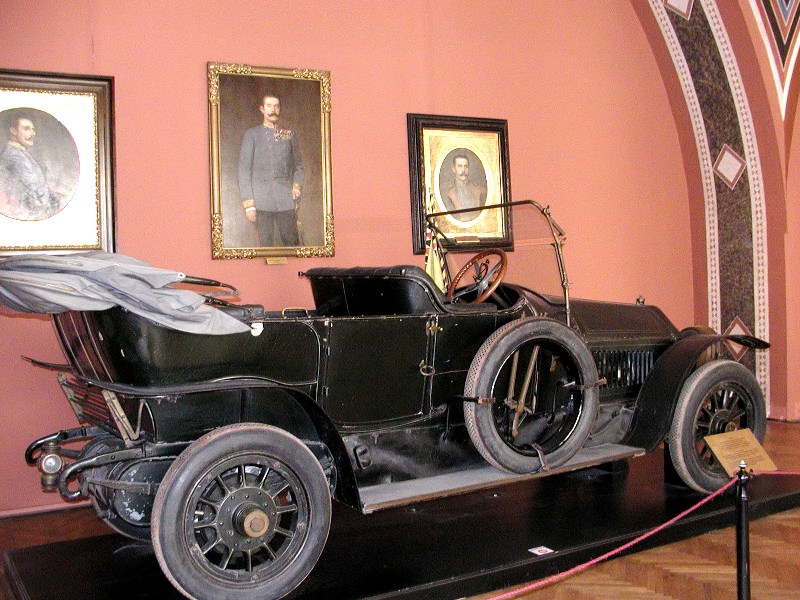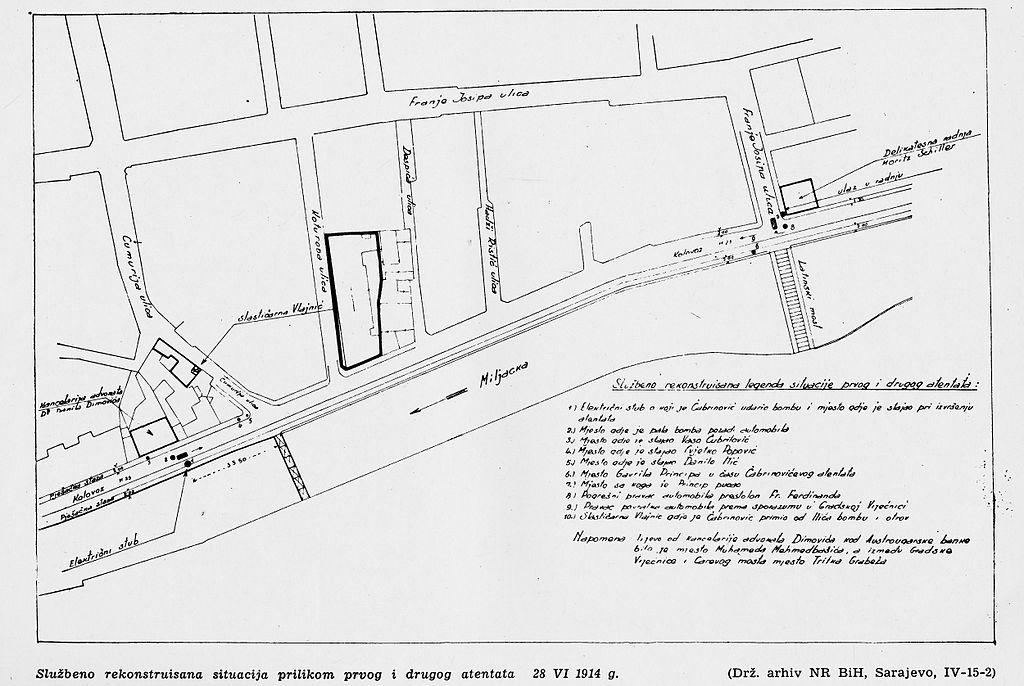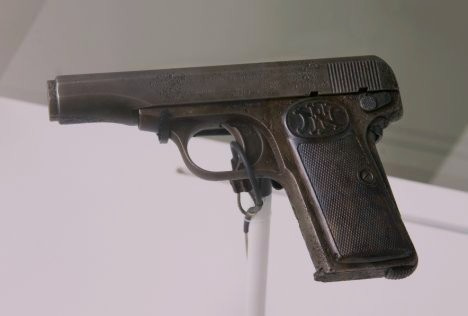General Discussion
Related: Editorials & Other Articles, Issue Forums, Alliance Forums, Region Forums106 Years Ago Today; Archduke Franz Ferdinand and wife, Sophie are murdered in Sarajevo

Assassination illustrated in the Italian newspaper Domenica del Corriere, 12 July 1914 by Achille Beltrame
The assassination of Archduke Franz Ferdinand of Austria, heir presumptive to the Austro-Hungarian throne, and Franz Ferdinand's wife Sophie, Duchess of Hohenberg, occurred on 28 June 1914 in Sarajevo when they were mortally wounded by Gavrilo Princip. Princip was one of a group of six assassins (five Serbs and one Bosniak) coordinated by Danilo Ilić, a Bosnian Serb and a member of the Black Hand secret society. The political objective of the assassination was to break off Austria-Hungary's South Slav provinces so they could be combined into a Yugoslavia. The conspirators' motives were consistent with the movement that later became known as Young Bosnia. The assassination led directly to World War I when Austria-Hungary subsequently issued an ultimatum to the Kingdom of Serbia, which was partially rejected. Austria-Hungary then declared war on Serbia, triggering actions leading to war between most European states.
In charge of these Serbian military conspirators was Chief of Serbian Military Intelligence Dragutin Dimitrijević, his right-hand man Major Vojislav Tankosić, and the spy Rade Malobabić. Tankosić armed the assassins with bombs and pistols and trained them. The assassins were given access to the same clandestine network of safe-houses and agents that Malobabić used for the infiltration of weapons and operatives into Austria-Hungary.
The assassins, the key members of the clandestine network, and the key Serbian military conspirators who were still alive were arrested, tried, convicted and punished. Those who were arrested in Bosnia were tried in Sarajevo in October 1914. The other conspirators were arrested and tried before a Serbian court on the French-controlled Salonika Front in 1916–1917 on unrelated false charges; Serbia executed three of the top military conspirators. Much of what is known about the assassinations comes from these two trials and related records.
<snip>
Assassination

The 1911 Gräf & Stift 28/32 PS Double Phaeton in which the Archduke Franz Ferdinand was riding at the time of his assassination, Museum of Military History, Vienna (2003)
Motorcade
On the morning of 28 June 1914, Franz Ferdinand and his party proceeded by train from Ilidža Spa to Sarajevo. Governor Oskar Potiorek met the party at Sarajevo station. Six automobiles were waiting. By mistake, three local police officers got into the first car with the chief officer of special security; the special security officers who were supposed to accompany their chief got left behind. The second car carried the Mayor and the Chief of Police of Sarajevo. The third car in the motorcade was a Gräf & Stift 28/32 PS open sports car with its top folded down. Franz Ferdinand, Sophie, Governor Potiorek, and Lieutenant Colonel Count Franz von Harrach rode in this third car. The motorcade's first stop on the preannounced program was for a brief inspection of a military barracks. According to the program, at 10:00 a.m., the motorcade was to leave the barracks for the town hall by way of the Appel Quay.
Security arrangements within Sarajevo were limited. The local military commander, General Michael von Appel, proposed that troops line the intended route but was told that this would offend the loyal citizenry. Protection for the visiting party was accordingly left to the Sarajevo police, of whom only about 60 were on duty on the Sunday of the visit.
Bombing

A map annotated with the events of 28 June 1914, from an official report
The motorcade passed the first assassin, Mehmedbašić. Danilo Ilić had placed him in front of the garden of the Mostar Cafe and armed him with a bomb. Mehmedbašić failed to act. Ilić had placed Vaso Čubrilović next to Mehmedbašić, arming him with a pistol and a bomb. He too failed to act. Further along the route, Ilić had placed Nedeljko Čabrinović on the opposite side of the street near the Miljacka River, arming him with a bomb.
At 10:10 am, Franz Ferdinand's car approached and Čabrinović threw his bomb. The bomb bounced off the folded back convertible cover into the street. The bomb's timed detonator caused it to explode under the next car, putting that car out of action, leaving a 1-foot-diameter (0.30 m), 6.5-inch-deep (170 mm) crater, and wounding 16–20 people.
Čabrinović swallowed his cyanide pill and jumped into the Miljacka river. Čabrinović's suicide attempt failed, as the old cyanide only induced vomiting, and the Miljacka was only 13 cm deep due to the hot, dry summer. Police dragged Čabrinović out of the river, and he was severely beaten by the crowd before being taken into custody.
The procession sped away towards the Town Hall leaving the disabled car behind. Cvjetko Popović, Gavrilo Princip, and Trifun Grabež failed to act as the motorcade passed them at high speed.
Town Hall reception

A map showing the route of Archduke Franz Ferdinand's motorcade
Arriving at the Town Hall for a scheduled reception, Franz Ferdinand showed understandable signs of stress, interrupting a prepared speech of welcome by Mayor Fehim Curčić to protest: "Mr. Mayor, I came here on a visit and I am greeted with bombs. It is outrageous." Duchess Sophie then whispered into Franz Ferdinand's ear, and after a pause, Franz Ferdinand said to the mayor: "Now you may speak." He then became calm and the mayor gave his speech. Franz Ferdinand had to wait as his own speech, still wet with blood from being in the damaged car, was brought to him. To the prepared text he added a few remarks about the day's events thanking the people of Sarajevo for their ovations "as I see in them an expression of their joy at the failure of the attempt at assassination."
Officials and members of the Archduke's party discussed what to do next. The archduke's chamberlain, Baron Rumerskirch, proposed that the couple remain at the Town Hall until troops could be brought into the city to line the streets. Governor-General Oskar Potiorek vetoed this suggestion on the grounds that soldiers coming straight from maneuvers would not have the dress uniforms appropriate for such duties. "Do you think that Sarajevo is full of assassins?" he concluded.
Franz Ferdinand and Sophie gave up their planned program in favor of visiting the wounded from the bombing, at the hospital. Count Harrach took up a position on the left-hand running board of Franz Ferdinand's car to protect the Archduke from any assault from the riverside of the street. This is confirmed by photographs of the scene outside the Town Hall. At 10:45 a.m, Franz Ferdinand and Sophie got back into the motorcade, once again in the third car. In order to ensure the safety of the couple, General Oskar Potiorek decided that the imperial motorcade should travel straight along the Appel Quay to the Sarajevo Hospital so that they could avoid the crowded city center. However, Potiorek failed to communicate his decision to the drivers. As a result, the Archduke's driver, Leopold Lojka, took a right turn at the Latin Bridge just as the two drivers ahead of him. According to the historian Joachim Remak, the reason for this is that Potiorek's aide Eric(h) von Merrizzi was in the hospital, and was therefore unable to give Lojka the information about the change in plans and the driving route. The Sarajevo Chief of Police Edmund Gerde, who had earlier repeatedly warned Potiorek of insufficient security precautions for the imperial visit, was asked by one of the Archduke’s aides to tell the drivers of the new route, but in the confusion and tensions of the moment, he neglected to do so.
Fatal shooting

The aftermath of the assassination

Princip's FN Model 1910 pistol, displayed at the Museum of Military History, Vienna, 2009
After learning that the first assassination attempt had been unsuccessful, Princip thought about a position to assassinate the Archduke on his return journey, and decided to move to a position in front of a nearby food shop (Schiller's delicatessen), near the Latin Bridge. At this point, the first and second cars of the Archduke's motorcade suddenly turned right into a side street, leaving the Appel Quay. When the Archduke’s driver followed their route, Governor Potiorek, who was sharing the third vehicle with the Imperial couple, called out to the driver to stop as he was going the wrong way. As the driver applied the brakes to stop the car close to where Princip was standing, the assassin stepped up to the footboard of the car, and shot Franz Ferdinand and Sophie at point‐blank range using a Belgian-made Fabrique Nationale model 1910 .32 caliber pistol. Pistol serial numbers 19074, 19075, 19120 and 19126 were supplied to the assassins; Princip used #19074. According to Albertini, "the first bullet wounded the Archduke in the jugular vein, the second inflicted an abdominal wound on the Duchess." Princip tried to shoot himself, but was immediately seized and arrested. At his sentencing, Princip stated that his intention had been to kill Governor Potiorek, rather than Sophie.
After being shot, Sophie immediately fell unconscious and collapsed onto Franz Ferdinand’s legs. The Archduke, too, lost consciousness while being driven to the Governor's residence for medical treatment. As reported by Count Harrach, Franz Ferdinand's last words were "Sophie, Sophie! Don't die! Live for our children!" followed by six or seven utterances of "It is nothing," in response to Harrach's inquiry as to Franz Ferdinand's injury. These utterances were followed by a violent choking sound caused by hemorrhage. The imperial couple were dead by 11:30 a.m on 28 June 1914; Sophie was dead on arrival at the Governor's residence, and Franz Ferdinand died 10 minutes later.
Funeral
The bodies were transported to Trieste by the battleship SMS Viribus Unitis and then to Vienna by special train. Even though most foreign royalty had planned to attend, they were pointedly disinvited and the funeral was just the immediate imperial family, with the dead couple's three children excluded from the few public ceremonies. The officer corps was forbidden to salute the funeral train, and this led to a minor revolt led by Archduke Karl, the new heir presumptive. The public viewing of the coffins was curtailed severely and even more scandalously, Montenuovo tried unsuccessfully to make the children foot the bill. The Archduke and Duchess were interred at Artstetten Castle because the Duchess could not be buried in the Imperial Crypt.
Aftermath

Crowds on the streets in the aftermath of the Anti-Serb riots in Sarajevo, 29 June 1914
All of the assassins were eventually caught. Those in Austro-Hungarian custody were tried together with members of the infiltration route who had helped deliver them and their weapons to Sarajevo. Mehmedbašić was arrested in Montenegro, but was allowed to "escape" to Serbia where he joined Major Tankosić's auxiliaries, but in 1916 Serbia imprisoned him on other false charges (see criminal penalty section below).
Anti-Serb rioting broke out in Sarajevo and various other places within Austria-Hungary in the hours following the assassination until order was restored by the military. On the night of the assassination, country-wide anti-Serb pogroms and demonstrations were also organized in other parts of the Austro-Hungarian Empire, particularly on the territory of modern-day Bosnia and Herzegovina and Croatia. They were organized and stimulated by Oskar Potiorek, the Austro-Hungarian governor of Bosnia and Herzegovina. The first anti-Serb demonstrations, led by the followers of Josip Frank, were organized in early evening of 28 June in Zagreb. The following day, anti-Serb demonstrations in Sarajevo became more violent and could be characterized as a pogrom. The police and local authorities in the city did nothing to prevent anti-Serb violence. Writer Ivo Andrić referred to the violence in Sarajevo as the "Sarajevo frenzy of hate." Two Serbs were killed on the first day of pogrom in Sarajevo, many were attacked, while around 1,000 houses, shops, schools and institutions (such as banks, hotels, printing houses) owned by Serbs were razed or pillaged.
</snip>
secondwind
(16,903 posts)Thanks for posting this! I really got into it...
PCIntern
(25,544 posts)You know, I had never read a blow-by-blow account of this remarkable episode in history. I was born into the post World War II era and everything was about World War II with Nary a mention of World War I. I am often embarrassed how little history I am aware of, given my interest, you would think that I would try to expand my horizons.But to this point I haven’t really.
Again thanks for posting this it was very educational.
modrepub
(3,495 posts)Was an interesting read. Princip probably wouldn't have been successful if the Archduke hadn't retraced his path after the first attempt. Kind of a first rule of security after an assassination attempt, don't follow your announced itinerary. Guess he felt changing his visit itinerary would show some type of weakness.
Princip was not not of legal age to face the death penalty, though records of his birth date were a point of contention. In stead he was given life in prison. (Guess the Austrians were sticklers for rules) His sentence was carried out such that he was only allowed one day a year out in the sun. Princip died several years later and for most people is just a minor note in history.
The book I read interweaved Princip's life (as much as we know) with the 1990s Balkan war and other histories of that part of the world. Seems the animosity in that part of the world is deeply ingrained.